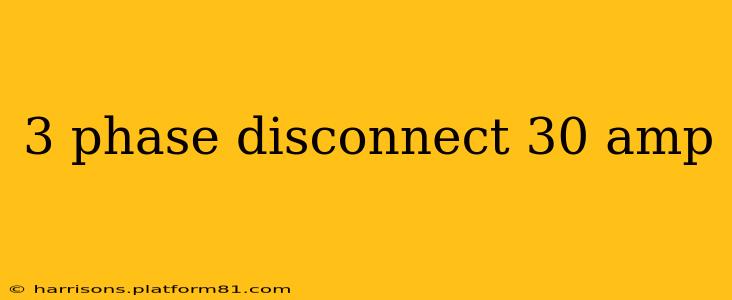A 3-phase 30-amp disconnect is a crucial safety and control device used in electrical systems to isolate power to equipment or circuits. Understanding its function, application, and safety protocols is vital for electricians, homeowners, and anyone working with three-phase power. This guide provides a comprehensive overview, addressing common questions and concerns.
What is a 3-Phase Disconnect?
A 3-phase disconnect switch, also known as a 3-pole disconnect switch, is a switching device designed to interrupt the flow of electricity in a three-phase electrical system. Unlike single-phase disconnects, these switches control three separate hot wires (phases) simultaneously, providing complete isolation of the load. The 30-amp rating indicates the maximum current the switch can safely handle. Exceeding this rating can cause overheating, damage to the switch, and potentially fire hazards. These disconnects are commonly used in industrial, commercial, and some high-power residential settings.
What are the Applications of a 3-Phase 30 Amp Disconnect?
3-phase 30-amp disconnects find applications in various settings requiring the control and isolation of 3-phase power. Some common uses include:
- Motor Control: Controlling the power supply to three-phase electric motors, commonly found in machinery, pumps, and HVAC systems. The disconnect allows for safe isolation of the motor for maintenance or repairs.
- Equipment Isolation: Isolating larger pieces of equipment that operate on 3-phase power, ensuring safety during maintenance or troubleshooting.
- Subpanel Protection: Protecting subpanels that receive 3-phase power. The disconnect serves as the primary disconnect for the subpanel.
- Service Entrance: In some limited-capacity commercial or industrial applications, it might serve as part of the service entrance, although larger installations generally use higher-capacity disconnects.
How Does a 3-Phase 30 Amp Disconnect Work?
A 3-phase 30-amp disconnect operates by physically separating the conductors carrying the three phases of power from the load. The switch typically incorporates three contact points, one for each phase, along with a neutral connection (and possibly a ground connection). When the switch is in the "OFF" position, all three phases are disconnected, completely isolating the load from the power source.
What are the Safety Precautions When Using a 3-Phase 30 Amp Disconnect?
Safety is paramount when working with electrical systems. Always adhere to these precautions when working with a 3-phase 30-amp disconnect:
- Lockout/Tagout: Always implement proper lockout/tagout procedures before working on any electrical equipment. This prevents accidental energization.
- Personal Protective Equipment (PPE): Use appropriate PPE, including insulated gloves, safety glasses, and arc flash protective clothing, as necessary.
- Voltage Verification: Before touching any electrical components, verify that the power is OFF using a reliable voltage tester.
- Qualified Personnel: Work should only be performed by qualified electricians familiar with 3-phase systems and safety protocols.
- Proper Wiring: Ensure all wiring connections are secure and correctly installed according to the electrical code.
What is the difference between a 3-phase disconnect and a single-phase disconnect?
The key difference lies in the number of phases they handle. A single-phase disconnect controls one hot wire and one neutral wire, suitable for standard household circuits. A three-phase disconnect controls three hot wires plus a neutral (and often a ground), essential for systems requiring higher power. The 3-phase disconnect is required for equipment that operates on 3-phase power.
Where can I buy a 3-phase 30-amp disconnect?
3-phase 30-amp disconnects can be purchased from electrical supply houses, online retailers specializing in electrical equipment, and some home improvement stores (though availability may be limited). It is crucial to purchase disconnects that meet the requirements of your local electrical code.
How do I choose the right 3-phase 30-amp disconnect for my application?
Selecting the correct disconnect involves considering several factors, including the amperage rating (matching the load requirements), the type of enclosure (indoor vs. outdoor), and compliance with local electrical codes. Consulting a qualified electrician is highly recommended to ensure proper selection and installation.
This guide provides a comprehensive overview of 3-phase 30-amp disconnects. Remember that working with electricity can be dangerous, and safety should always be the top priority. If you are unsure about any aspect of this process, please consult a qualified electrician.
